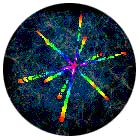The SCIET is the Mathematical Atom
May 1999
The Greek philosopher Democrates proposed that nature is composed of minimum units of matter that cannot be subdivided into smaller parts. In modern times chemistry and physics picked up the idea and it has evolved into today's atomic sciences. Although we now know that the atom is not the smallest unit of matter, the quest for what is smallest continues. Indications are that ``smallest" may be defined not by what exists in nature, but by what we can detect.
The SCIET approach to the idea of a minimum unit is mathematical. A single mathematical process or cycle exists that can be used to understand and describe all of nature. It can, for instance, be used to explain the nature of consciousness and the origin of the central nervous system and the brain as the evolved result of movement on the surface of the planet. (See BioSCIET, NeuroSCIET, AstroSCIET) Yes, a single pattern derived from charge polarity can be repeated and overlaid to create all of nature.
History has numerous references to simple ideas leading to complex understandings. In two dimensions sacred geometry has communicated the mystery of spheres within spheres, overlapping and interconnecting to create all that is. The adept student knows that creation is in three dimensions interpenetrated with layers, levels, planes and dimensions separated only by the eye of the observer, that in the fine air of the first creation pure geometry ruled and now continues to rule, seen only by the mystic in that moment. Spheres derived from line and angle, subdivisions of proportion and beginnings without ends.
The Greek's sacred solids hint at the same reality presented by the SCIET, that geometry of planes evolves into three dimensional form, but differs in that insights common to modern times resolves the formation and nature of the forms. Integrating issues of creation from the void, the source of spin, spherical charge and the coexistence of the visible and invisible from the most primitive beginnings can be shown to derive from ideas held by the ancient Greeks.
The Chinese Taoist concept of the Yin and Yang illustrates the shift of polarity within a system, it is an analogy for the pattern of change seen in the SCIET. Intuitively grasped insights of nature are presented by the language of the culture that they occur within and the same reality is shown by SCIET Theory.
The SCIET cycle continues endlessly and within its process all directions and points are defined until they cease to exist, returned to that from which they came, but leaving behind a spherical memory. Almost nothing, it is everything. These are the knowings of the adept who has seen what cannot be seen. But mystery is no longer required. Rules that allow for compounding polarity effects enable the evolution of the void into everything that exists in the Universe.
The SCIET can be understood with thought experiments. The nervous system and brain are the evolved result of our cells interaction with the environment around them. Since our cells have DNA that has been alive and moving continuously since the beginning of life on this planet, we will include our solar system as part of the environment. Movement through space drives the evolution of the nervous system and our minds are the evolved result of this interaction. So thought experiments that examine our experience and interpretation of it are at the heart of understanding the SCIET and its role in nature. The brain and mind are the product of the SCIET and provide a laboratory unequaled in science.
Once understood, the Single Cycle Integrative Effect Topology theory is so obvious that we can see it in everything. The process of thought itself is one good example of the SCIET in action .
What is a thought? What is the process of thinking? Questions are themselves the key to exploring how it works. When we posit a question, we create a logical ``singularity" an unmatched value that extends throughout our mental landscape until it ``finds" a match or an ``answer". Found, the answer creates a path or line of relationship between itself and the questioner, collapsing the global search and initiating an examination of the consequences of the choice or ``answer". The ``examination" proceeds from generalities to details until it is disproved or ``fails", and creates a new question and the process begins again. When it does not fail the result can be an epiphany, uniting areas of experience previously thought unrelated. Within this series of mental events we find analogies to quantum functions and holography.
Understanding the mathematical atom begins with self-awareness. Think and discover.
DMA May 1999
|




